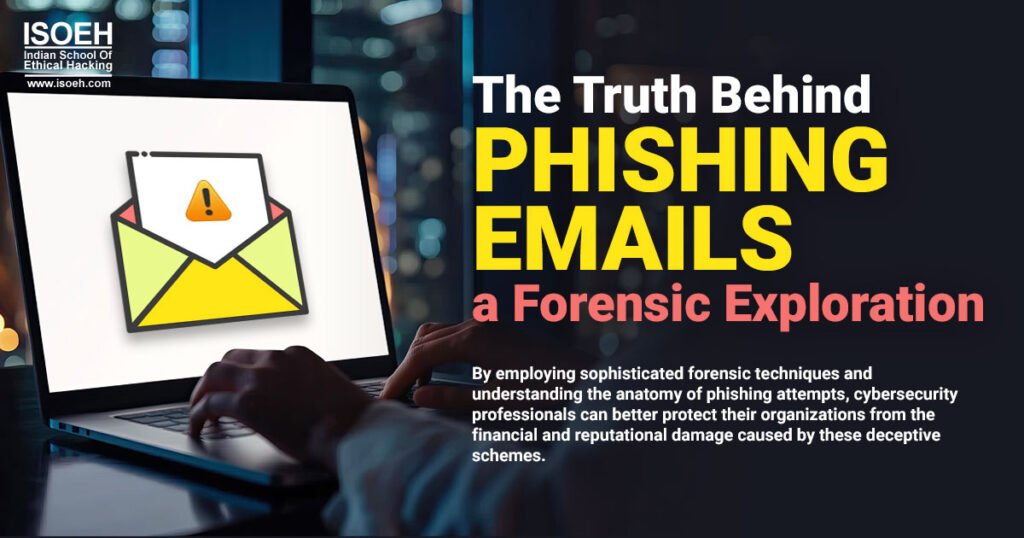The Truth Behind Phishing Emails a Forensic Exploration
Phishing attacks remain a significant threat in the cyber landscape, deceiving individuals into revealing sensitive information through seemingly legitimate emails. This blog explores the forensic techniques used to analyze phishing emails and presents real-world case studies to illustrate these methods in action. By understanding these techniques, cybersecurity professionals can better identify and mitigate these insidious threats.
The Anatomy of a Phishing Email
Identifying Suspicious Elements: Every phishing email is crafted to deceive, but certain elements often give them away. These include:
Mismatched URLs: Hovering over any link in the email will show a different URL than the one displayed.
Generic Salutations: Phishing attempts often use vague greetings like “Dear Customer” instead of personal names.
Urgency and Threats: Phishing emails commonly create a sense of urgency, pressuring the recipient to act quickly.
Technical Headers and Metadata Analysis: A deeper look into an email’s headers can reveal the email’s journey. Important fields include:
Return-Path: Identifies where the email originated.
Received from: Shows the server path the email has taken.
X-Mailer: Indicates the email client used to send the message.
Tools and Techniques for Forensic Email Analysis
Email Header Analysers: Tools like MX Toolbox and Email Header Analyzer can decode email headers and expose routing information and originating IPs, crucial for tracking the source of a phishing attempt.
Link and Attachment Scanners: Before clicking any link or opening an attachment, use tools like Virus Total to scan for potential threats. These services check against a database of known phishing sites and malware.
Digital Forensics Software: Programs like The Sleuth Kit and Autopsy can analyze email artifacts, helping to uncover deleted or hidden data within phishing emails.
Case Studies: Real-World Phishing Forensics
Case Study 1: The CEO Fraud Incident
In this high-profile case, a company was nearly defrauded out of a substantial amount of money through a carefully crafted phishing email that appeared to be from the CEO. Forensic analysis revealed that the email originated from a server known for hosting phishing sites, as identified through an examination of the IP address in the email header.
Case Study 2: The Bank Phishing Scam
A series of customers received emails purportedly from their bank, asking them to update their account information. Forensic experts employed digital forensic software to analyze the attachments, which were found to contain keyloggers designed to steal credentials. The metadata of the files revealed inconsistencies with genuine bank communications, including timestamps that didn’t align with the bank’s official communication logs.
Advanced Techniques in Phishing Forensics
Machine Learning for Phishing Detection: Advanced forensic teams use machine learning algorithms to predict and identify phishing attempts. These systems analyze thousands of features of emails, including text patterns and metadata, to learn and predict phishing characteristics.
Threat Intelligence Platforms: By integrating threat intelligence platforms, organizations can access real-time data about current phishing campaigns. This information allows them to anticipate and react more effectively to phishing attempts.
Sandboxing: In a controlled environment, forensic experts can safely execute suspicious links or attachments, observing the behavior without risking the security of their networks.
Conclusion: The Critical Role of Phishing Forensics
The continuous evolution of phishing techniques necessitates an equally dynamic approach to cybersecurity. Forensic analysis of phishing emails is not just about understanding how an attack happened, but also about learning and preparing for future threats. By employing sophisticated forensic techniques and understanding the anatomy of phishing attempts, cybersecurity professionals can better protect their organizations from the financial and reputational damage caused by these deceptive schemes.

